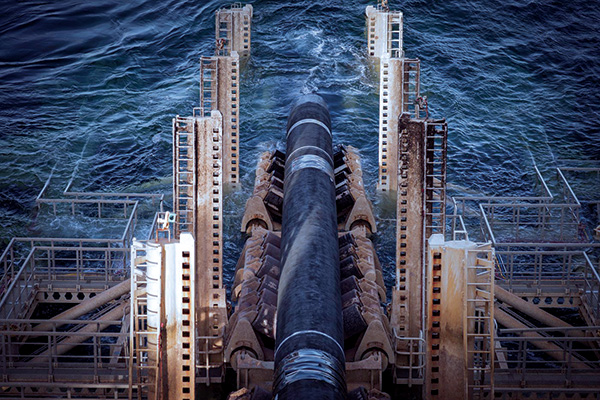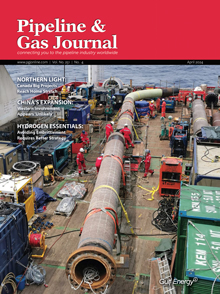June 2020, Vol. 247, No. 6
Global News
Global News
Texas, Oklahoma Regulators Reject Production Curbs
Regulatory agencies in Texas and Oklahoma both opted not to impose limits on crude oil production within their states despite a historic drop in prices and shrinking storage availability.
The Oklahoma Corporation Commission took no action in May after hearing proposals to declare some oil production in the state as economic waste, or on an industry trade group’s recommended plan that included mandated output cuts.
That hearing closely followed a Texas Railroad Commission decision not to mandate oil production cuts, ending a month-long debate about whether they would wade into global oil politics for the first time in 50 years as crude prices cratered.
The severe price downturn in April had prompted Commissioner Ryan Sitton to push the idea of production cuts after two companies asked for the state to mandate 20% curtailments, or 1 million barrels. Sitton promoted the curbs on Twitter and television and won audiences from OPEC and Russian energy leaders. But a motion to consider widespread production curbs was dismissed by a 2-1 vote.
Texas and Oklahoma can curb oil production to prevent waste of the states’ natural resources, but stopping production takes time and must be done carefully to avoid damaging future output. Shut-ins also can cause an oil and gas producer to lose their right to drill under many leases.
“The industry and the market move a lot faster than we can as a regulatory body,” Texas Railroad Commissioner Christi Craddick said.
Texas is the top U.S. oil producing state. Oklahoma ranked fourth in 2019 behind North Dakota and New Mexico, according to the U.S. Energy Information Administration.
Russian Pipelaying Vessel Reaches Baltic as Nord Stream 2 Target Looms
The Gazprom-owned pipelaying vessel Akademik Cherskiy has arrived in Baltic Sea from the Russian Pacific port of Nakhodka, Reuters reported, suggesting that completion of the Nordic 2 pipeline remains a priority for Moscow despite U.S. sanction.

Russia’s energy ministry said in December that the pipeline was expected to be launched before the end of 2020, and footage taken by Reuters in early May showed the vessel idle in a bay near the Kaliningrad region, between Poland and Lithuania.
The United States says the pipeline would make the continent too reliant for energy on Russia, leaving it in Moscow’s political grip. Washington has touted exports of U.S. LNG, to provide Europe with an alternative to dry gas delivered via pipeline from Russia.
As a result of the sanctions, the Swiss-Dutch company Allseas, which was laying the pipeline, suspended work on it. Only a stretch of about 100 miles (160 km) of construction remains for the Nord Stream 2 near the Danish island of Bornholm.
U.S. Delays Pipeline Approvals After Environmental Ruling
The U.S. Army Corps of Engineers suspended a nationwide environmental permitting program for oil and gas pipelines, power lines and other utility work after a court ruling that industry representatives warned could slow or halt numerous infrastructure projects.
The directive from Army Corps headquarters was issued after a federal court threw out a blanket permit that companies and public utilities have used for decades to build projects across streams and wetlands.
The federal judge later revised the ruling to allow permitting to resume for electrical lines and some other work but left in place a requirement for new oil and gas pipelines to undergo further environmental review.
TC Energy said it could face up to a one-year delay building the Keystone XL oil pipeline after the legal setback and was looking at options to keep work progressing,
Texas Eastern Pipelines Shut After Kentucky Blast
Three of Enbridge’s pipelines were shut following a fire on the company’s Line 10 segment of its Texas Eastern Natural Gas System in Kentucky, and the company said it had no estimated timeline to resume service.
No injuries were reported in the fire, which occurred in a wooded area on May 4. That shutdown stopped gas from flowing through the damaged section of pipe from the Marcellus/Utica Shale in Pennsylvania, Ohio and West Virginia to the U.S. Gulf Coast.
Texas Eastern has three lines between its Danville and Tompkinsville compressors in Kentucky that make up its 30-inch (76-centimeter) system. They are Lines 10, 15 and 25. More than 1 Bcf of gas was flowing through the area before the shutdown.
Enbridge to Store Canadian Crude in Section of Line 3 Pipeline
Enbridge said it reached a deal with shippers to temporarily store crude oil in its Mainline network from June 1 and is working with governments to provide additional capacity.
The Mainline, Canada’s largest oil pipeline system, has capacity for nearly 3 MMbpd, moving western Canadian oil to U.S. refiners.
Toronto-based Enbridge said it is offering about 900,000 barrels of storage for an eight-month term, using an older portion of its Line 3 pipeline in Canada before the line is decommissioned next year.
“This temporary storage, along with the further maintenance optimizations to our storage tank program will create more than two million barrels of additional storage capacity for 2020,” a company spokesperson said.
Calcasieu Pass Raises Roof for First LNG Storage Tank
Venture Global LNG raised the first LNG storage tank roof at its Calcasieu Pass export facility in Cameron Parish, Louisiana, in late April, just eight months after the project’s final investment decision (FID).
CB&I Storage Tank Solutions, a division of McDermott International, Inc., is constructing the project’s dual 200,000 m3 tanks and raised the tank dome in less than two hours. Weeks Marine and the project’s EPC contractor, Kiewit, completed the export facility’s marine perimeter wall, including access gates and a levee.
The focus has since turned to installation of the project’s modular equipment. The first pipe-rack modules arrived at the site and were successfully installed in April, and equipment for the project’s 720 MW combined cycle gas turbine power plant were scheduled for May delivery.
Freeport LNG Starts Commercial Operation of Third Train
Freeport LNG began commercial operations for its third liquefaction train with the commencement of liquefaction services to Total S.A. and SK E&S under their tolling agreements with Freeport.
Freeport LNG’s liquefaction facility is the seventh largest in the world and the second largest in the United States. Train 1 began commercial operations in mid-December and Train 2 began in January. Train 3 started commercial operations on Friday. A planned fourth liquefaction train has received all regulatory approvals for construction.
Freeport LNG, a limited partnership, was formed in 2002 to develop, own and operate an LNG terminal on Quintana Island, near Freeport, Texas. The terminal started LNG import operations in June 2008 and began LNG export operations in 2019.
Poland’s PGNiG Receives LNG Delivery from U.S.
Poland’s dominant gas firm PGNiG has received its third LNG delivery from U.S. company Cheniere under a long-term contract as Warsaw moves to reduce reliance on Russian supplies.
The LNG carrier GasLog Warsaw arrived at the Swinoujscie terminal from Sabine Pass, Louisiana, with a cargo of 70,000 tonnes of LNG or 95 million cubic meters after regasification.
“Despite the global turbulences related to the coronavirus pandemic, LNG supplies flow to Poland without any interruptions and as planned,” PGNiG Chief Executive Jerzy Kwiecinski said.
PGNiG signed a long-term deal with Cheniere Marketing International in 2018 under which PGNiG was to receive a total of 0.52 million tonnes of LNG in the period 2019-22 and 29 million tonnes from 2023-42.
Poland received its first LNG cargo from the United States in 2017, a spot delivery from Cheniere Energy.
CPC Oil Producers Eye New Transit Routes via Russia’s Transneft
Kazakh oil producers, which export crude via the Caspian Pipeline Consortium (CPC), were seeking to divert flows to Russia’s Transneft from May in an attempt to minimize losses as CPC Blend margins and demand fall, market sources told Reuters.
Companies including Chevron’s Tengizchevroil, Karachaganak Petroleum Operating (KPO) and state-owned Kazmunaigaz (KMG) plan to redirect 4.5 million barrels to transit via Russia’s Novorossiisk and Ust-Luga ports, the sources said.
This would allow them to mix their barrels and to export Urals oil instead that trades $5-6 a barrel above the CPC Blend and is much easier to place, they said.
Oil blended for the CPC route is known as CPC Blend while for Transneft destinations Kazakh barrels are mixed with Russian grades and sold as Urals Blend.
Storms Damage Kinder Morgan Sabine Pass Pipeline
Kinder Morgan Inc’s Natural Gas Pipeline Co of America (NGPL) subsidiary said that no transport services would be available “until further notice” at the Sabine Pass delivery point in Louisiana after severe storms damaged the pipeline in that area.
NGPL said in its notice to customers that the April 29 storm was a “force majeure” event, and the pipe has “experienced damage related to severe storms at the ... Sabine Pass delivery point ... that requires immediate investigation and repairs.”
Officials at Cheniere Energy Inc, which owns the Sabine Pass LNG export plant, said there was no impact on operations at its facility.
Moda Midstream Completes Crude Oil Storage Expansion
Liquids terminaling and logistics provider Moda Midstream announced it has placed the final 495,000-barrel tank from its 10-million-barrel crude oil expansion into service at the Moda Ingleside Energy Center (MIEC) in Ingleside, Texas, and the Moda Taft Terminal in Taft, Texas.
Storage capacity at MIEC and the Moda Taft Terminal to approximately 12 million barrels with the expansion.
Construction has begun at MIEC on a new expansion phase of an additional 3.5 million barrels of crude oil storage. Moda expects to begin placing storage tanks from this expansion into service later this year.
Moda said it also has obtained permits to build more storage capacity and is discussing further expansions with its customers.
Shell Midstream Offers Mars Sour Crude Storage as Offshore Producers Keep Pumping
Shell Midstream Partners said it began offering storage in its Mars Sour crude cavern on the U.S. Gulf Coast, as offshore producers continued production at higher levels than onshore following the sharp market downturn.
Because offshore production is not as easy to bring offline as short-cycle oil output like shale, some of that crude is going into storage. Overall U.S. Gulf Coast storage was 60% full by early May, according to U.S. Energy Department figures.
“Wherever we have a barrel of storage, we’re pulling that because storage is a hot commodity right now,” Shell Midstream CEO Kevin Nichols said.






Comments